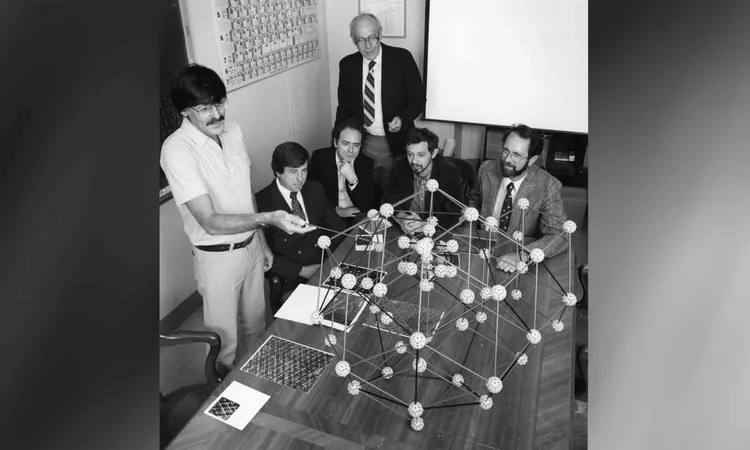
Scientists Unveil the 4D 'Shadow' of Quasicrystals, Confirming Revolutionary Theories!
2025-05-23
Author: Jia
A Breakthrough in Crystallography
In a stunning revelation that echoes back to 1982, scientists have confirmed that quasicrystals, once deemed perplexing anomalies in material science, can be understood through the lens of higher-dimensional patterns. This groundbreaking research not only validates the work of Nobel laureate Dan Shechtman but also expands our understanding of matter itself.
Unpacking Quasicrystals: More than Meets the Eye
Quasicrystals were initially discovered as structures that break the conventional rules of crystallography, featuring ordered arrangements without the repetitive patterns typically seen in regular crystals. Recent findings, led by Prof. Guy Bartal from the Technion, reveal that these peculiar formations can be linked to periodic patterns in a higher dimension, affecting their energetic behaviors.
Exploring the 4D Tesseract
Imagine a tesseract, a four-dimensional hypercube that embodies a mysterious extra direction beyond length, width, and height. Although these objects elude direct observation, scientists can analyze their projections in lower dimensions, revealing surprising properties hidden within their 'shadows'.
Sudden Waves of Discovery
An eager research team has uncovered extraordinary patterns in how electromagnetic waves traverse quasicrystal surfaces. By employing advanced imaging techniques, like near-field scanning optical microscopy, they found that previously distinct patterns appear identical when limited to two-dimensional analysis. This revelation highlights the necessity of considering the higher-dimensional structure for a fuller understanding.
Time Warp: A Glimpse into the Attosecond Realm
In an astonishing twist, researchers observed overlaps in the structural patterns of quasicrystals within attoseconds—billionths of a billionth of a second! This fleeting moment revealed a wild interplay between topological and thermodynamic forces, suggesting a tug-of-war between sustaining energy and geometric constraints.
Theoretical Foundations: Penrose and Beyond
The theoretical groundwork for such phenomena can be traced back to the insightful work of Dov Levine and Paul Steinhardt, who asserted that quasicrystals hold clues to periodic forms in dimensions beyond our comprehension. This approach closely aligns with Sir Roger Penrose's tilings, which showcase hidden order beneath their non-repeating structures.
Quasicrystals: The Future of Data?
The implications of these quasicrystal patterns could revolutionize our data handling techniques, potentially leading to breakthroughs in quantum computing. Their unique configurations might even pave new pathways for secure information storage in advanced communication systems.
A New Frontier in Material Science
As scientists delve deeper into these four-dimensional shadows, they aim to reveal how quasicrystals adapt to various forces and environments. The competition between thermodynamic stability and structural design could open the door to finely-tuned materials tailored for specific applications.
The Big Picture: Extending Beyond Electromagnetism
This research isn't just groundbreaking for electromagnetism; it could also extend to acoustic waves and electronic structures within solid materials. Such revelations promise to reshape our understanding of symmetry and order, intertwining geometry, physics, and mathematics.
What's Next for Researchers?
As teams from the University of Stuttgart and the University of Duisburg-Essen work together to confirm these findings across various lattice types, they anticipate that 4D concepts will shape the future of material design. This could lead to unprecedented methods for manipulating electromagnetic and acoustic fields—transforming our scientific landscape.
Stay Tuned for More Groundbreaking Discoveries!
Although the realm of four-dimensional objects remains beyond direct human perception, the pursuit of their 'shadows' is a thrilling journey that reshapes our concept of reality. With these findings now published in Science, the excitement surrounding quasicrystals and their hidden realms is just beginning!


 Brasil (PT)
Brasil (PT)
 Canada (EN)
Canada (EN)
 Chile (ES)
Chile (ES)
 Česko (CS)
Česko (CS)
 대한민국 (KO)
대한민국 (KO)
 España (ES)
España (ES)
 France (FR)
France (FR)
 Hong Kong (EN)
Hong Kong (EN)
 Italia (IT)
Italia (IT)
 日本 (JA)
日本 (JA)
 Magyarország (HU)
Magyarország (HU)
 Norge (NO)
Norge (NO)
 Polska (PL)
Polska (PL)
 Schweiz (DE)
Schweiz (DE)
 Singapore (EN)
Singapore (EN)
 Sverige (SV)
Sverige (SV)
 Suomi (FI)
Suomi (FI)
 Türkiye (TR)
Türkiye (TR)
 الإمارات العربية المتحدة (AR)
الإمارات العربية المتحدة (AR)